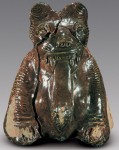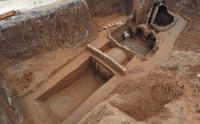 The richly adorned tomb of a warrior from China’s Three Kingdoms period (ca. 220-280 A.D.) has been discovered in Xiangyang, central China. Archaeologists first unearthed the tomb in 2008, but it has only recently been published in the English-language journal Chinese Archaeology which is why we’re hearing about it now.
The richly adorned tomb of a warrior from China’s Three Kingdoms period (ca. 220-280 A.D.) has been discovered in Xiangyang, central China. Archaeologists first unearthed the tomb in 2008, but it has only recently been published in the English-language journal Chinese Archaeology which is why we’re hearing about it now.
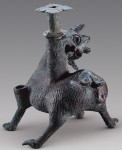 The warrior was laid to rest alongside his wife in a multi-chambered brick tomb with a domed roof. He and his wife were buried in wooden coffins that have long since rotted away, leaving behind their skeletal remains. Scientists estimate that the warrior was about 45 years old when he died, and the wealth of artifacts left to accompany him in the afterlife indicates that he was a fighting man of considerable status. The artifacts discovered date the tomb to the early Three Kingdoms period, around 220 A.D.
The warrior was laid to rest alongside his wife in a multi-chambered brick tomb with a domed roof. He and his wife were buried in wooden coffins that have long since rotted away, leaving behind their skeletal remains. Scientists estimate that the warrior was about 45 years old when he died, and the wealth of artifacts left to accompany him in the afterlife indicates that he was a fighting man of considerable status. The artifacts discovered date the tomb to the early Three Kingdoms period, around 220 A.D.
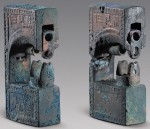 Some historians date the period to the fall of the Han Dynasty in 184 A.D., but its formal start is 220 A.D., the year the last nominal Han Emperor Xian was forced to abdicate and the third kingdom, Wei, was founded by Cao Pi, self-styled emperor and the son of the legendary General Cao Cao. Cao Cao occupied Xiangyang in 208 A.D. and used it as the base of operations for his attempted conquest of former Han territories south of the Yangtze River. His invasion was thwarted at the Battle of Red Cliffs in the winter of 208/209 A.D., but he, and later his son, retained control of Xiangyang which was even more strategically significant once it was right on the border with the enemy kingdom of Wu.
Some historians date the period to the fall of the Han Dynasty in 184 A.D., but its formal start is 220 A.D., the year the last nominal Han Emperor Xian was forced to abdicate and the third kingdom, Wei, was founded by Cao Pi, self-styled emperor and the son of the legendary General Cao Cao. Cao Cao occupied Xiangyang in 208 A.D. and used it as the base of operations for his attempted conquest of former Han territories south of the Yangtze River. His invasion was thwarted at the Battle of Red Cliffs in the winter of 208/209 A.D., but he, and later his son, retained control of Xiangyang which was even more strategically significant once it was right on the border with the enemy kingdom of Wu.
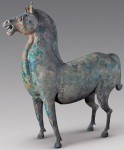 Given the richness of the unnamed warrior’s burial, its early date and the military importance of Xiangyang, he may well have served under Cao Cao or Cao Pi themselves.
Given the richness of the unnamed warrior’s burial, its early date and the military importance of Xiangyang, he may well have served under Cao Cao or Cao Pi themselves.
The artifacts discovered are not just beautiful, although they certainly are that, but are also of notable historical importance. First and foremost is a life-sized bronze horse. It is 5.3 feet long by 5.3 feet tall making it the largest of its kind ever discovered in China. The detail is exquisite. He is depicted with his mouth open, his ears pricked up and pointed forward, his mane short and upright. It’s possible that the statue depicts an actual horse the warrior rode in life and wanted to have with him in the afterlife.
 Another piece of great interest to historians is a glazed pottery model of a two-story mansion. The model is about 3.4 feet tall and includes details like the knockers on each of the two gate doors. Miniature pottery houses were popular in the Han Dynasty, but this level of detail and multiple stories are very rare even from the more stable earlier period. Since few remains of the buildings from late Han, early Three Kingdoms have been found in the archaeological record, all we have to go on is descriptions in the literature of the era and the pottery miniatures found in tombs. A model of such size and detail is therefore priceless to students of ancient Chinese architecture.
Another piece of great interest to historians is a glazed pottery model of a two-story mansion. The model is about 3.4 feet tall and includes details like the knockers on each of the two gate doors. Miniature pottery houses were popular in the Han Dynasty, but this level of detail and multiple stories are very rare even from the more stable earlier period. Since few remains of the buildings from late Han, early Three Kingdoms have been found in the archaeological record, all we have to go on is descriptions in the literature of the era and the pottery miniatures found in tombs. A model of such size and detail is therefore priceless to students of ancient Chinese architecture.
The treasures found in this tomb go on and on, gold and silver disks, crystal and agate beads, gold bracelets, just to name a few.
Among the finds is a jade pig figurine, his snout finely detailed, the tiny animal having apparently gone to sleep. Another work of art shows a glazed pottery figurine of a dog barking furiously while standing on all fours.
Yet another piece shows a beastly tomb guardian, his long tongue sticking out and, grossly enough, “a crawling animal is attached onto the tip of the tongue,” [archaeologist Liu] Jiangsheng writes.
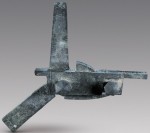 There are also bronze and iron weapons, including a bronze crossbow trigger which is in excellent condition despite its advanced age, as well as a bronze mirror decorated on the back with stylized imagery of a phoenix, the one-legged mountain demon/rain god Kui and two inscriptions: “To benefit the descendants forever” and “May the holder get the position of the Three Dukes,” the three most important officials in ancient China, just underneath the emperor.
There are also bronze and iron weapons, including a bronze crossbow trigger which is in excellent condition despite its advanced age, as well as a bronze mirror decorated on the back with stylized imagery of a phoenix, the one-legged mountain demon/rain god Kui and two inscriptions: “To benefit the descendants forever” and “May the holder get the position of the Three Dukes,” the three most important officials in ancient China, just underneath the emperor. 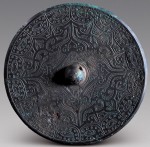 Interestingly, it was Cao Cao who abolished the positions of the Three Dukes (Chancellor, Imperial Secretary, Grand Commandant of the Military) and integrated them all into a single Imperial Chancellor in 208 A.D.
Interestingly, it was Cao Cao who abolished the positions of the Three Dukes (Chancellor, Imperial Secretary, Grand Commandant of the Military) and integrated them all into a single Imperial Chancellor in 208 A.D.
For more pictures of the extraordinary contents of the tomb, see the LiveScience photo gallery.
